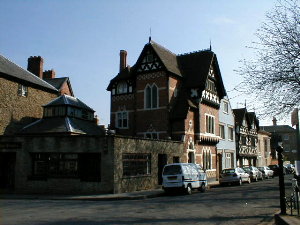Abberley, Herefordshire &
Worcestershire
For the next week, we rented a cottage on Old Yates Farm in the small village
of Abberley, close to the town of Worcester, in the beautiful Heart of
England. Just say "Aaaahhh...."

Our cottage and the others near it used to be dependencies of a large
estate. We stayed in the cottage where the keeper of the master's
hounds lived -- the two-storey portion at the far end in the picture on
the left. The one-storey part used to be the dog kennel, and is now
a second cottage. The former gamekeeper's and forester's cottages
were just a stone's throw away. Click here
for interior cottage pictures and details of how we found this marvelous
place.
Our rented cottage near Abberley, and the view
from the door on a snowy April morning.
Abberley itself is a tiny village, about a mile down narrow lanes from
our cottage. Aside from the nice old church, the houses, a private
school (on the grounds of which the clock tower in the right picture stands),
and the post office/shop, there's not much there, but it was a perfect
base for touring the area. The counties of Herefordshire and Worcestershire
(H&W) and Shropshire have an appeal that is very different from the
Cotswolds. The wealth of the Cotswolds was based on wool, and that
wealth built the golden stone villages and towns where wool was processed
and traded. Now, although sheep graze in the meadows, parts of the
Cotswolds seem to be largely showpieces, relying heavily on tourism.
By contrast, the area where we stayed and toured in the Heart of England
is more varied, less touristed. There are many farms... black-and-white
and brick buildings, as well as stone ones... old fortifications once intended
to secure the Welsh Borders... and areas that were transformed by the Industrial
Revolution.
 Beautiful Shropshire.
Beautiful Shropshire.
Elsewhere you can see pictures of the country houses and museums we
visited in these counties. Below, I have pictures of two towns:
Bridgnorth and Ludlow.
Bridgnorth
Bridgnorth is a splendid little town, built in two halves above and below
a sandstone cliff. There are castle ruins dating from 1098, a serene
"close" around the church, and a cablecar on the cliff for those who don't
want to walk one of the seven sets of stairs between High Town and Low
Town. The town was once a bustling trading center with warehouses
serving traffic on the busy Severn River, and the first steam locomotive
was built just up the river -- but about the only active reminder of the
town's role in the Industrial Revolution is the Severn Valley Railway,
which now runs steam excursion trains through the countryside.
In addition to offering scenic and historic interest, the town seems (based
on our very short visit) clean, busy, and self-sufficient. Coming
from America, where small towns and independent main-street businesses
are threatened by large-scale commercialism, we were pleased to note the
apparent vitality of the community, with large numbers of people conducting
their business in the small High Street shops. The old Town Hall
is set in the middle of the road, built just after the English Civil War
and with arches intended, presumably, to enable vendors to set up their
wares in the open lower storey. We had a nice afternoon visiting
the shops and walking through the streets. We bought lunch at a bakeshop
and stopped to eat it halfway down Stoneway Steps to Low Town.
Below, Bridgnorth from the bridge, the Market
Hall, and the path (mostly sandstone steps except for this bit) between
the upper and lower parts of town.
Ludlow
How we ended up in Ludlow: Illness made us cancel our plans for a
hike in the Malverns. Someone recommended to us the village of Much
Wenlock for antique shopping and scenery. It had a little of each,
but after an hour we were ready for something else. We took a splendid
drive through the Shropshire countryside, enjoying the sight of farmhouses,
villages, and the rolling green hills, and ended up in Ludlow. Many
medieval/Tudor buildings still stand there, and automotive traffic and
modern activity manage to be compatible with narrow, crooked streets.
We toured the castle
and
walked all through the town. The weather was lovely, the town was
a fascinating mix of building styles, and we had a great time. We
drove home on the high road, over Clee Hill where snow still lingered.
Ludlow: note the mix of building styles,
and, in the picture on the right, the upper storeys overhanging the street.
Go FORWARD to the next town or village
Go BACK to the top of the Towns and Villages
section
Go HOME to our top
travel page




 Beautiful Shropshire.
Beautiful Shropshire.



